Page 100 of 157
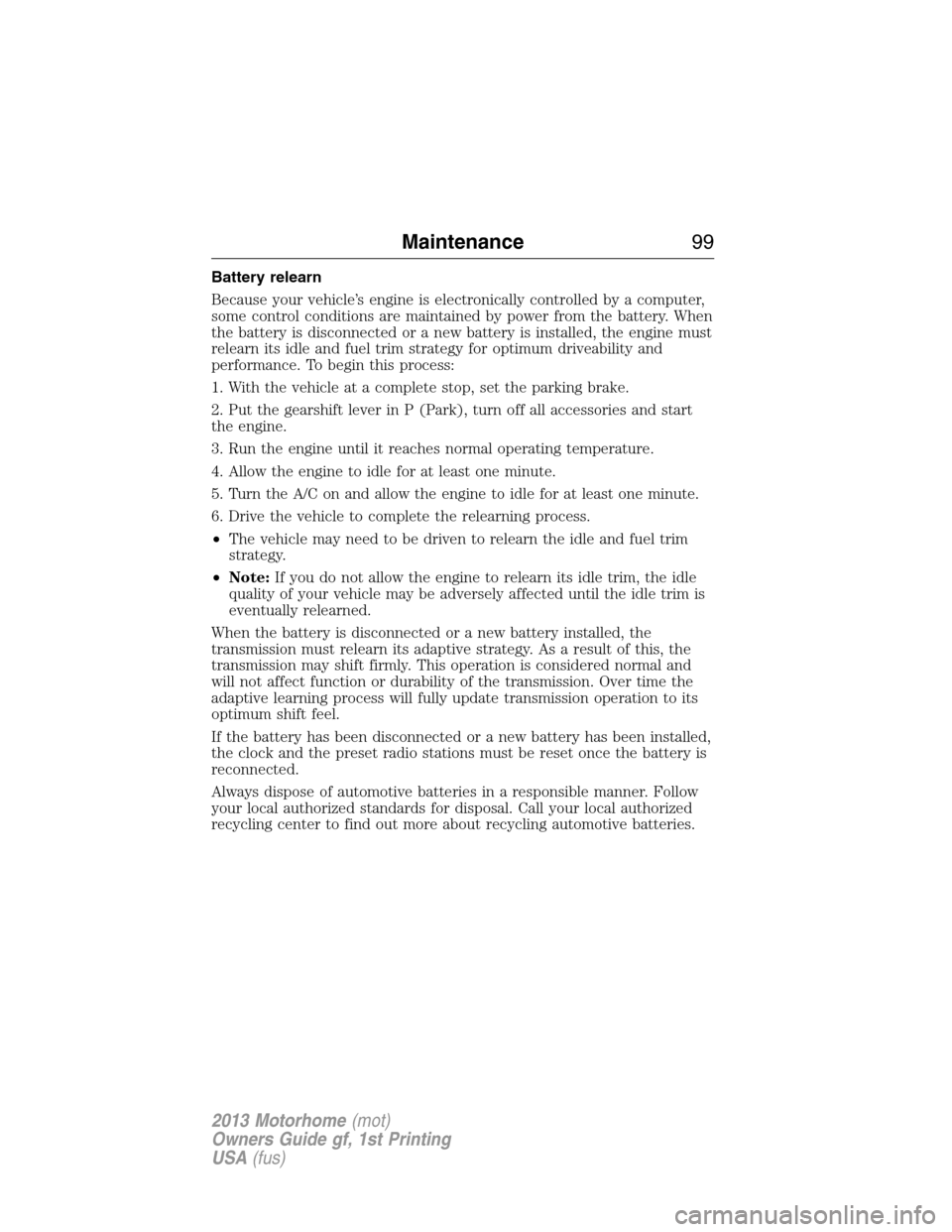
Battery relearn
Because your vehicle’s engine is electronically controlled by a computer,
some control conditions are maintained by power from the battery. When
the battery is disconnected or a new battery is installed, the engine must
relearn its idle and fuel trim strategy for optimum driveability and
performance. To begin this process:
1. With the vehicle at a complete stop, set the parking brake.
2. Put the gearshift lever in P (Park), turn off all accessories and start
the engine.
3. Run the engine until it reaches normal operating temperature.
4. Allow the engine to idle for at least one minute.
5. Turn the A/C on and allow the engine to idle for at least one minute.
6. Drive the vehicle to complete the relearning process.
•The vehicle may need to be driven to relearn the idle and fuel trim
strategy.
•Note:If you do not allow the engine to relearn its idle trim, the idle
quality of your vehicle may be adversely affected until the idle trim is
eventually relearned.
When the battery is disconnected or a new battery installed, the
transmission must relearn its adaptive strategy. As a result of this, the
transmission may shift firmly. This operation is considered normal and
will not affect function or durability of the transmission. Over time the
adaptive learning process will fully update transmission operation to its
optimum shift feel.
If the battery has been disconnected or a new battery has been installed,
the clock and the preset radio stations must be reset once the battery is
reconnected.
Always dispose of automotive batteries in a responsible manner. Follow
your local authorized standards for disposal. Call your local authorized
recycling center to find out more about recycling automotive batteries.
Maintenance99
2013 Motorhome(mot)
Owners Guide gf, 1st Printing
USA(fus)
Page 101 of 157
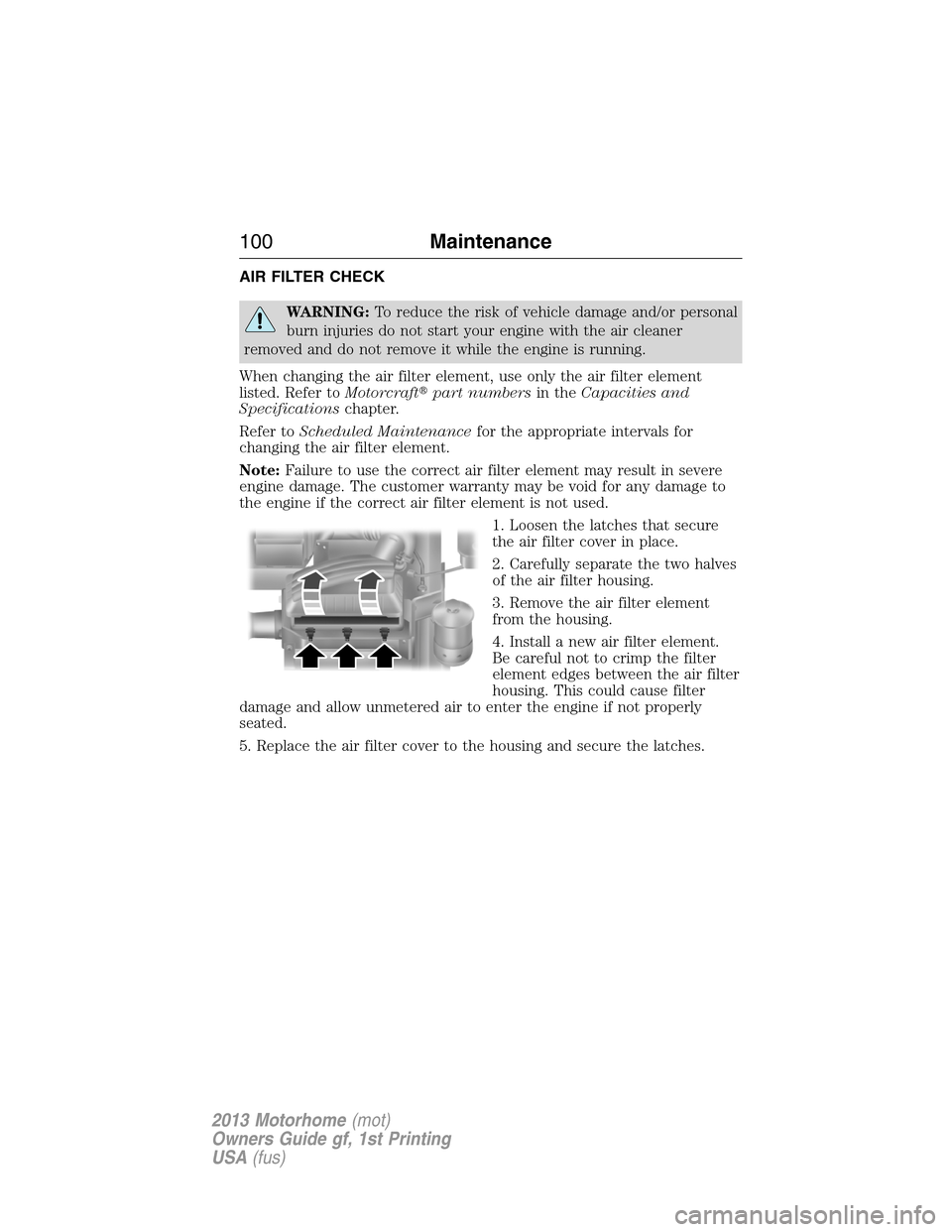
AIR FILTER CHECK
WARNING:To reduce the risk of vehicle damage and/or personal
burn injuries do not start your engine with the air cleaner
removed and do not remove it while the engine is running.
When changing the air filter element, use only the air filter element
listed. Refer toMotorcraft�part numbersin theCapacities and
Specificationschapter.
Refer toScheduled Maintenancefor the appropriate intervals for
changing the air filter element.
Note:Failure to use the correct air filter element may result in severe
engine damage. The customer warranty may be void for any damage to
the engine if the correct air filter element is not used.
1. Loosen the latches that secure
the air filter cover in place.
2. Carefully separate the two halves
of the air filter housing.
3. Remove the air filter element
from the housing.
4. Install a new air filter element.
Be careful not to crimp the filter
element edges between the air filter
housing. This could cause filter
damage and allow unmetered air to enter the engine if not properly
seated.
5. Replace the air filter cover to the housing and secure the latches.
100Maintenance
2013 Motorhome(mot)
Owners Guide gf, 1st Printing
USA(fus)
Page 102 of 157
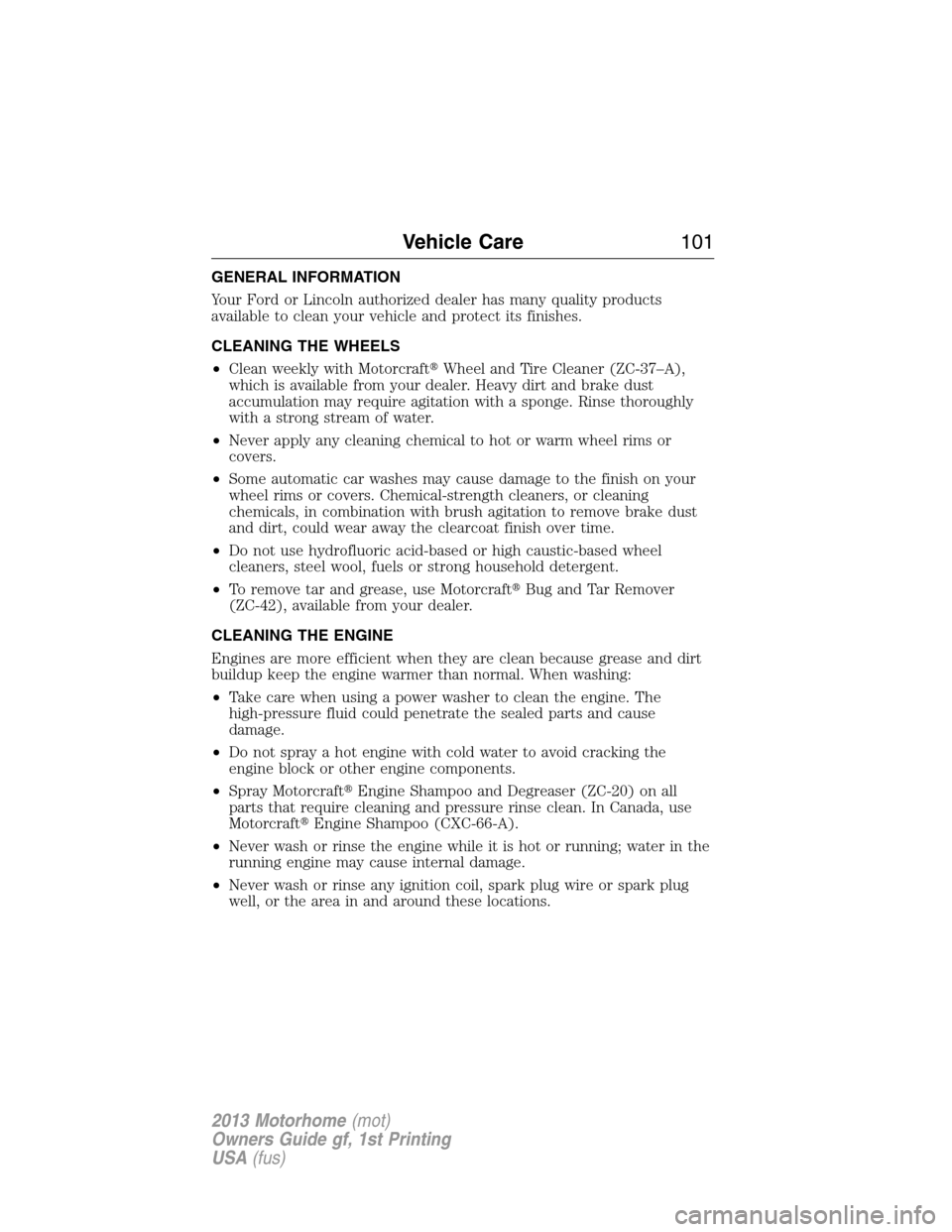
GENERAL INFORMATION
Your Ford or Lincoln authorized dealer has many quality products
available to clean your vehicle and protect its finishes.
CLEANING THE WHEELS
•Clean weekly with Motorcraft�Wheel and Tire Cleaner (ZC-37–A),
which is available from your dealer. Heavy dirt and brake dust
accumulation may require agitation with a sponge. Rinse thoroughly
with a strong stream of water.
•Never apply any cleaning chemical to hot or warm wheel rims or
covers.
•Some automatic car washes may cause damage to the finish on your
wheel rims or covers. Chemical-strength cleaners, or cleaning
chemicals, in combination with brush agitation to remove brake dust
and dirt, could wear away the clearcoat finish over time.
•Do not use hydrofluoric acid-based or high caustic-based wheel
cleaners, steel wool, fuels or strong household detergent.
•To remove tar and grease, use Motorcraft�Bug and Tar Remover
(ZC-42), available from your dealer.
CLEANING THE ENGINE
Engines are more efficient when they are clean because grease and dirt
buildup keep the engine warmer than normal. When washing:
•Take care when using a power washer to clean the engine. The
high-pressure fluid could penetrate the sealed parts and cause
damage.
•Do not spray a hot engine with cold water to avoid cracking the
engine block or other engine components.
•Spray Motorcraft�Engine Shampoo and Degreaser (ZC-20) on all
parts that require cleaning and pressure rinse clean. In Canada, use
Motorcraft�Engine Shampoo (CXC-66-A).
•Never wash or rinse the engine while it is hot or running; water in the
running engine may cause internal damage.
•Never wash or rinse any ignition coil, spark plug wire or spark plug
well, or the area in and around these locations.
Vehicle Care101
2013 Motorhome(mot)
Owners Guide gf, 1st Printing
USA(fus)
Page 103 of 157
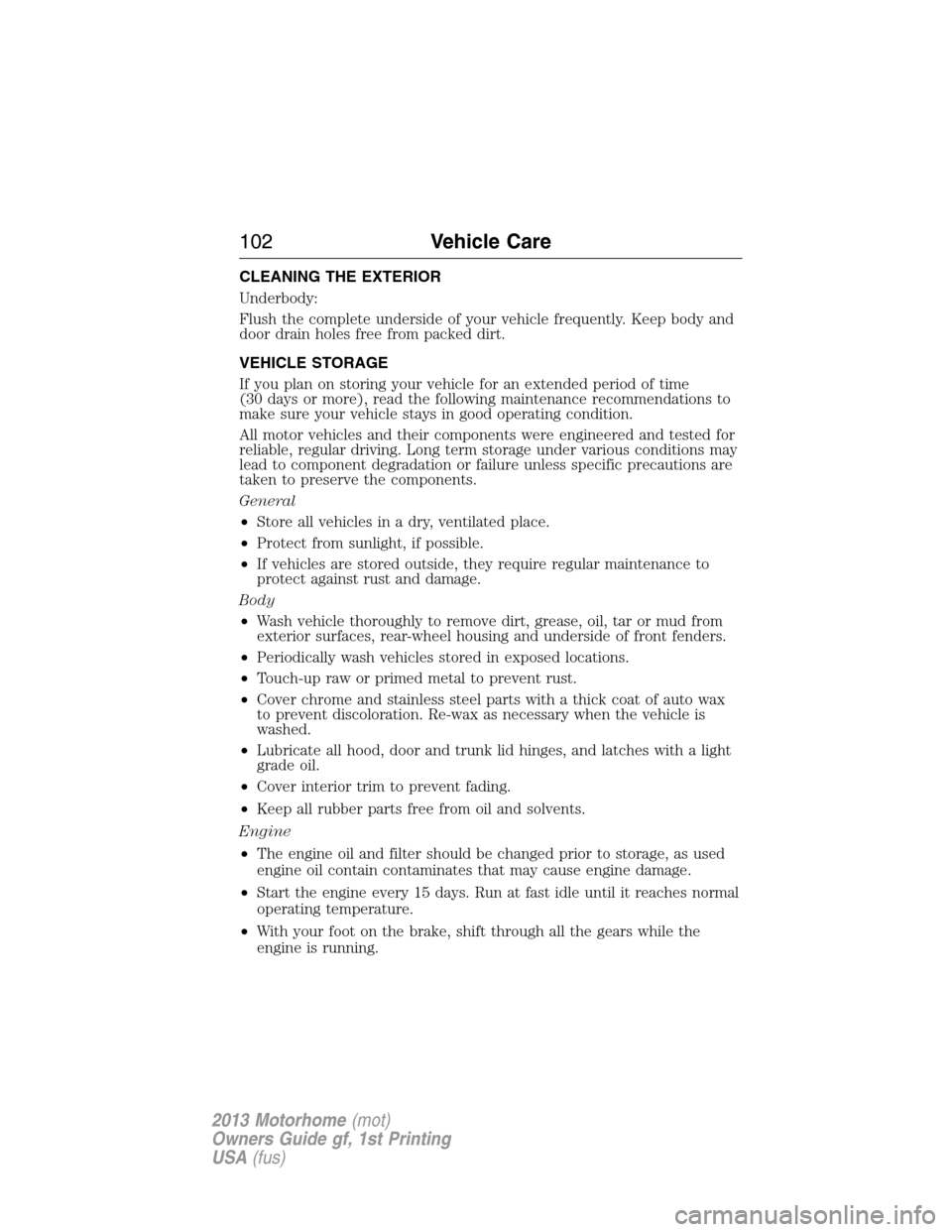
CLEANING THE EXTERIOR
Underbody:
Flush the complete underside of your vehicle frequently. Keep body and
door drain holes free from packed dirt.
VEHICLE STORAGE
If you plan on storing your vehicle for an extended period of time
(30 days or more), read the following maintenance recommendations to
make sure your vehicle stays in good operating condition.
All motor vehicles and their components were engineered and tested for
reliable, regular driving. Long term storage under various conditions may
lead to component degradation or failure unless specific precautions are
taken to preserve the components.
General
•Store all vehicles in a dry, ventilated place.
•Protect from sunlight, if possible.
•If vehicles are stored outside, they require regular maintenance to
protect against rust and damage.
Body
•Wash vehicle thoroughly to remove dirt, grease, oil, tar or mud from
exterior surfaces, rear-wheel housing and underside of front fenders.
•Periodically wash vehicles stored in exposed locations.
•Touch-up raw or primed metal to prevent rust.
•Cover chrome and stainless steel parts with a thick coat of auto wax
to prevent discoloration. Re-wax as necessary when the vehicle is
washed.
•Lubricate all hood, door and trunk lid hinges, and latches with a light
grade oil.
•Cover interior trim to prevent fading.
•Keep all rubber parts free from oil and solvents.
Engine
•The engine oil and filter should be changed prior to storage, as used
engine oil contain contaminates that may cause engine damage.
•Start the engine every 15 days. Run at fast idle until it reaches normal
operating temperature.
•With your foot on the brake, shift through all the gears while the
engine is running.
102Vehicle Care
2013 Motorhome(mot)
Owners Guide gf, 1st Printing
USA(fus)
Page 125 of 157
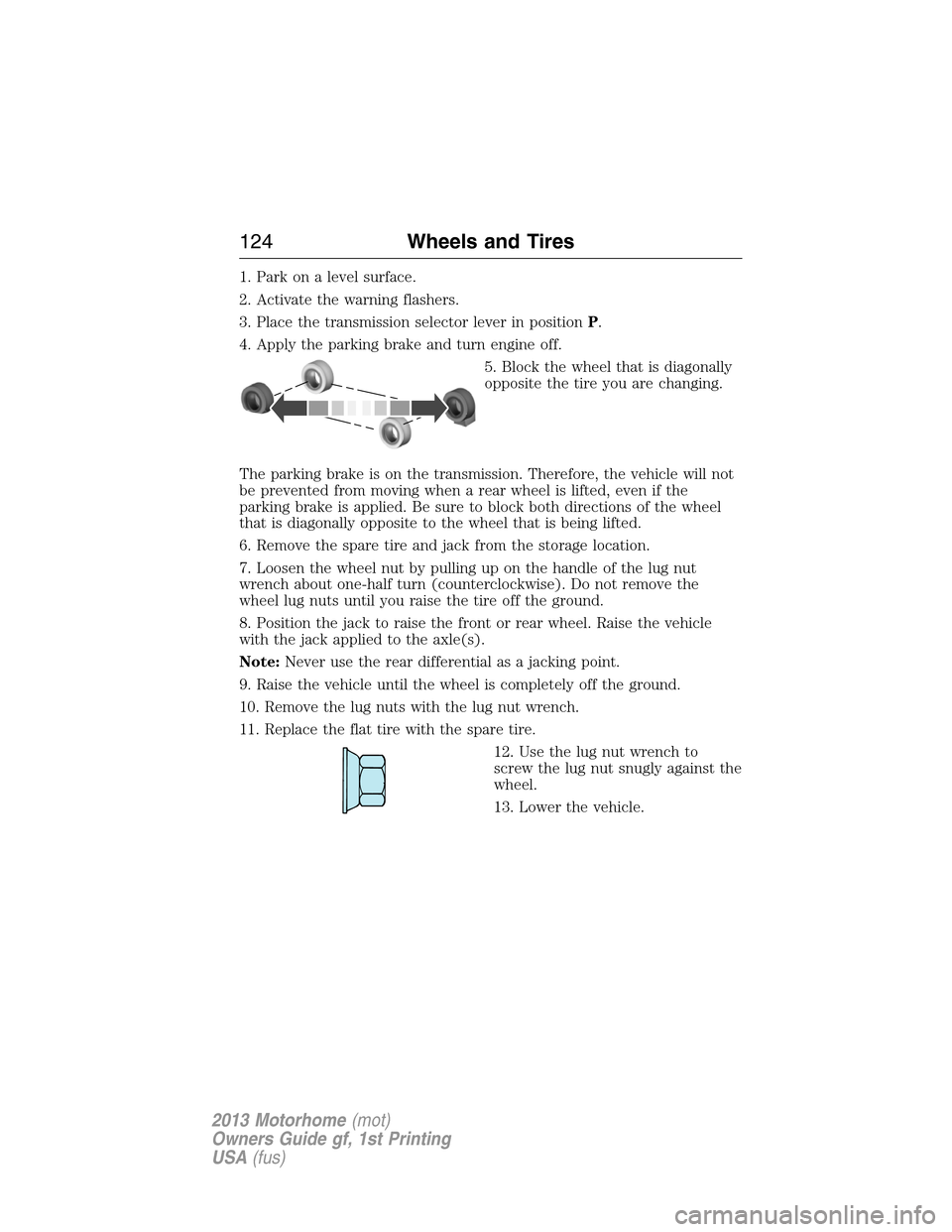
1. Park on a level surface.
2. Activate the warning flashers.
3. Place the transmission selector lever in positionP.
4. Apply the parking brake and turn engine off.
5. Block the wheel that is diagonally
opposite the tire you are changing.
The parking brake is on the transmission. Therefore, the vehicle will not
be prevented from moving when a rear wheel is lifted, even if the
parking brake is applied. Be sure to block both directions of the wheel
that is diagonally opposite to the wheel that is being lifted.
6. Remove the spare tire and jack from the storage location.
7. Loosen the wheel nut by pulling up on the handle of the lug nut
wrench about one-half turn (counterclockwise). Do not remove the
wheel lug nuts until you raise the tire off the ground.
8. Position the jack to raise the front or rear wheel. Raise the vehicle
with the jack applied to the axle(s).
Note:Never use the rear differential as a jacking point.
9. Raise the vehicle until the wheel is completely off the ground.
10. Remove the lug nuts with the lug nut wrench.
11. Replace the flat tire with the spare tire.
12. Use the lug nut wrench to
screw the lug nut snugly against the
wheel.
13. Lower the vehicle.
124Wheels and Tires
2013 Motorhome(mot)
Owners Guide gf, 1st Printing
USA(fus)
Page 128 of 157
ENGINE SPECIFICATIONS
Engine 6.8L V10 engine
Cubic inches 415
Required fuel Minimum 87 octane
Firing order 1-6-5-10-2-7-3-8-4-9
Ignition system Coil on plug
Spark plug gap 0.039-0.043 inch (1.00-1.10mm)
Compression ratio 9.2:1
Engine drivebelt routing
Engines with A/C
Engines without A/C
Capacities and Specifications127
2013 Motorhome(mot)
Owners Guide gf, 1st Printing
USA(fus)
Page 129 of 157
TECHNICAL SPECIFICATIONS
Item CapacityFord part name or
equivalentFord part number /
Ford specification
Brake fluid-Hydroboost
brake booster
system—Chassis with
Gross Vehicle Weight
Ratings of 16,000 lb
(7,257 kg), 18,000 lb
(8,165 kg) and 19,500 lb
(8,845 kg)
Between MIN and
MAX on reservoirMotorcraft�High
Performance DOT 3 Motor
Vehicle Brake FluidPM-1-C /
WSS-M6C62-A or
WSS-M6C65-A1
Brake fluid-Hydromax
brake booster
system—Chassis with
Gross Vehicle Weight
Ratings of 20,500 lb
(9,299 kg), 22,000 lb
(9,979 kg), 24,000 lb
(10,886 kg) and 26,000 lb
(11793 kg)DOT 5.1 Motor Vehicle
Brake FluidYS4Z-19542-AA /
ESD-M6C57-A or
WSS-M6C65-A2
Engine coolant
1,2
30.6 quarts (29.0L)Motorcraft�Premium Gold
Engine Coolant
(yellow-colored)VC-7-B (US)
CVC-7-B (Canada) /
WSS-M97B51-A1
128Capacities and Specifications
2013 Motorhome(mot)
Owners Guide gf, 1st Printing
USA(fus)
Page 130 of 157
Item CapacityFord part name or
equivalentFord part number /
Ford specification
Engine oil
3,4
7.0 quarts
(6.6L)Motorcraft�SAE 5W-20
Premium Synthetic Blend
Motor Oil (US)
Motorcraft�SAE 5W-20
Super Premium Motor Oil
(Canada)XO-5W20-QSP (US)
CXO-5W20-LSP12
(Canada) /
WSS-M2C945-A
Automatic transmission
TorqShift�5-speed
5,6
18.2 quarts (17.2L)
Motorcraft�
MERCON�LV AT FXT-10-QLV /
MERCON�LV
WSS-M2C938-A
Power steering fluidKeep in FULL
range on dipstick
Parking brake assemblyFill to bottom of fill
plug holeMotorcraft�
MERCON�VATFXT-5-QM /
MERCON�V
WSS-M2C938-A
Rear axle
7,8
4.0 quarts
(3.9L)
(Dana M80)
Motorcraft�SAE 75W-140
Synthetic Rear Axle
LubricantXY-75W140-QL /
WSL-M2C192-A and GL-5 8.0 quarts
(7.6L)
(Dana S110)
7.0 quarts
(6.6L)
(Dana S130)
16.0 quarts (15.1L)
(Dana Spicer
17060S)
Capacities and Specifications129
2013 Motorhome(mot)
Owners Guide gf, 1st Printing
USA(fus)